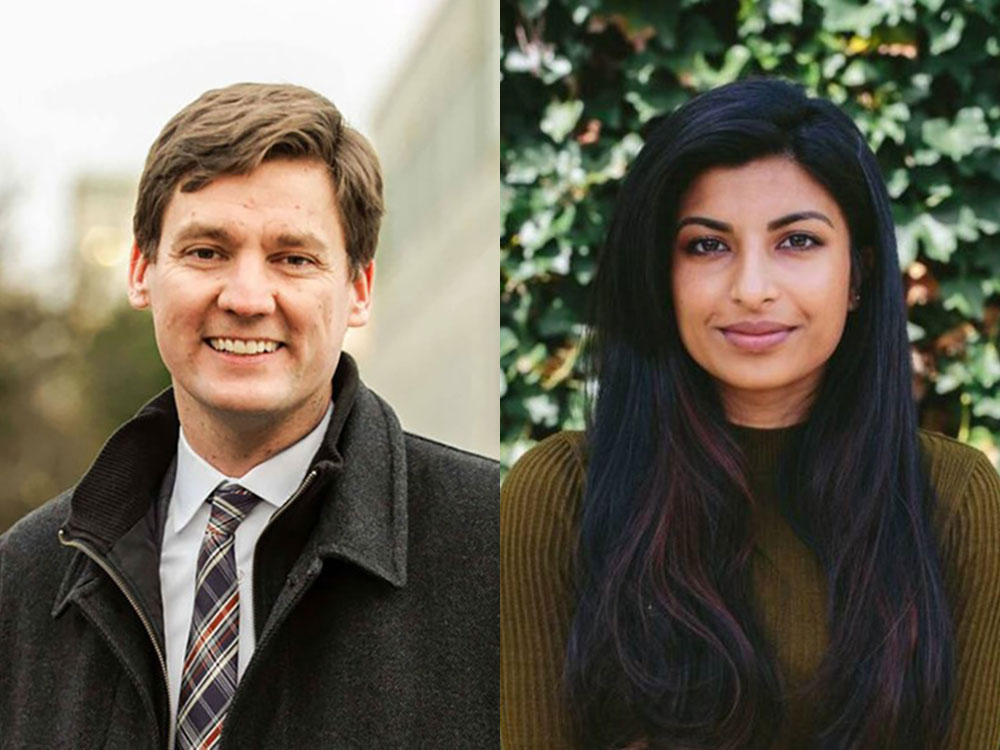When BC NDP leader hopeful David Eby last month said people who have overdosed from toxic drugs twice in a day should be given compulsory treatment instead of being discharged from the hospital, the response from harm reduction advocates was swift and skeptical.
Eby’s competitor for the BC NDP leadership, Anjali Appadurai, has added her voice to the critics, telling The Tyee, “Involuntary care is a policy on the wrong side of the required paradigm shift and flies in the face of civil liberties. What we need is an adequate, reliable and regulated safe supply, combined with expanded access to harm reduction supplies and community care services. We need to stop criminalizing people who are suffering, and we need to create a policy that is rooted in care. "
But Eby isn’t backing away. Earlier this week he told The Tyee, “More people than ever are dying in our streets due to the toxic drug supply. We must explore every possible solution to get people the life-saving support they need. That's what you do in a crisis.”
He added that any proposal will need to be thoroughly reviewed by experts and people within affected communities including people with existing substance use challenges and Indigenous communities where there is a history of forced separation.
Many who’ve criticized Eby’s idea cite B.C.’s scrapped Bill 22, which sought to force youth to undergo treatment for up to seven days after an overdose.
Support for the 2020 legislation came from parents, some health professionals and others who argued that some youth would benefit from the intervention by being offered counselling and treatment.
Hospital physicians “want the clear ability and guidelines to be able to hold these youth, give them time for some cognitive clearing, offer them treatment… or harm reduction to keep kids alive,” Kelowna pediatrician Tom Warshawski told the CBC in March of this year. Warshawski spearheads a group of health professionals examining secure care options for children and youth who are heavy substance users.
Eby’s statement also found resonance with BC Liberal Leader Kevin Falcon, who told CKNW that he supports the reinstatement of large institutions like Riverview modelled as modern, compassionate, apartment-like settings. He added that leaving people to their own devices on the streets is inhumane and deprives them of the proper care they need.
But B.C.’s own Centre for Disease Control has published a list of points against such measures.
Some experts warn that people weaned off drugs against their will may even run a higher chance of overdosing if they reuse, because their tolerance has lessened.
Marilou Gagnon, former president of the Harm Reduction Nurses Association, is among those who say forced treatment rarely works and can make things worse for drug users rather than encouraging them to quit.
Eby’s statements, says Gagnon, “following all the opposition that’s been voiced around Bill 22 exposes everything that is wrong with involuntary hospitalization. Being detained in a hospital against their consent is very traumatic.”
In six years, more than 10,000 deaths
On Aug. 18, while campaigning for the BC NDP leadership in the Okanagan, Eby told Postmedia News, “When someone overdoses twice in a day and they show up in the emergency room for the second time, a second overdose in the same day, the idea that we release that person back out into the street to overdose the third time and die or to have profound brain injury or just to come back to the emergency room again, seems very bizarre.”
Since the toxic drug crisis was first declared six years ago, more than 10,000 lives have been lost to it in B.C. The latest tally by the BC Coroners Service counts 1,095 deaths caused by toxic drug supply between January to June 2022, marking the highest ever recorded in the first six months of the calendar year.
Researchers and harm reduction advocates have pressed the federal and provincial governments to provide a safer supply of drugs.
But people like Brittany Graham, executive director at the Vancouver Area Network of Drug Users, an advocacy group that has boots on the ground in the Downtown Eastside, argue treatment for people who want to avoid the risk by quitting drugs is in short supply.
“There are three detox centres,” Graham says. “One of them accepts people who have benzodiazepines in their system. And it's the same one that accepts people on alcohol because withdrawal from benzos and alcohol is harder on your body. And so they need more supervision and training and all that sort of stuff. The other two detox centres don't currently take people who are withdrawing from alcohol or benzos.”
When there’s more awareness that drugs are being tainted with benzodiazepines, she asks why the government isn’t investing more money, time and training into existing centres so they can accommodate people withdrawing from benzos.
People in B.C seeking treatment or supportive housing face long waits, a fact Eby has acknowledged. “But for some folks,” he said last month, “they’re just never going to [seek treatment], so we’re going to need to do our best to give them a chance to survive.”
Eby also admitted that B.C. has a sorry history of support for Indigenous youth and teens in foster care.
“It’s not been a great record. So any kind of movement in that direction will have to be undertaken very carefully. But I fundamentally disagree with the idea that it is respectful of someone’s liberty and human rights to release them into the street to die of an overdose,” he said in August.
At the time Eby recognized that compulsory treatment under involuntary hospital care was a “hot-button issue.”
‘A very dramatic thing to suggest’
According to Graham, people forced into involuntary care will stop trusting their medical professionals because they're being forced into a system that they don’t want to be in.
“People need to make their own decisions and need to know what's best for them. And if they're forced into making decisions it’s not going to work.”
“It is a very dramatic thing to suggest,” says Dr. Paxton Bach, co-medical director at BC Centre on Substance Use and an addiction medicine physician at St. Paul’s Hospital. “I think that people have to remember that involuntary care means incarceration. It means security. It potentially means locked rooms and physical restraints. It potentially means sedation and it is not something to be suggested lightly. And it has the potential to cause trauma and irreparable harm between an individual and their trust in the health-care system.”
Each day, Bach and his team at St. Paul’s see 10 to 20 patients with a variety of addiction-related issues. At any given time, four physicians at the hospital are following between 60 to 100 admitted patients who are drug users.
“My colleagues and I have no interest in providing involuntary or compulsory care to these patients,” Bach said. “We want to try to help them access the evidence-based care that they're seeking.”
Graham says what’s needed is to acknowledge that the system is broken. “If someone wants to go into treatment or detox or any type of therapy at this time, it is either a two to eight-week wait, or it doesn't exist.”
VANDU has not released a formal statement regarding involuntary care for drug users at risk of overdose from toxic drugs, but Graham told The Tyee that they are strongly opposed to it.
Graham added, “You need to support drug users to empower people to understand the best way to protect themselves while using drugs.”
Part of possible long-term solutions that don’t include involuntary care is better funding for drug user groups, Graham said. “There was a fund last year called the Provincial Peer Network. Three million dollars were set aside for peer-led drug user groups, out of a $600 million budget. These groups created programs with naloxone training, injection facilities and safer consumption sites.”
Bach believes our attention needs to be on measures sought by people with lived experience and those working on the frontlines with them. He also emphasizes the need to address significant social inequities like extreme poverty, homelessness and the inability to access health care in general.
“We desperately need to improve the quality of addiction treatment that we provide in this province and build a patient-centric system that speaks to the needs of those who have to access it,” Bach said.
In the meantime, harm reduction nurse Gagnon says B.C. should be making it harder rather than easier to hold patients in hospital against their wishes. Gagnon described the province as a legal outlier.
“B.C. is the only place in Canada where when you're involuntarily detained in the hospital, we assume that you consent to treatment, so you have no option to decline.”
Voting for the new BC NDP leader begins Nov. 13. ![]()
Read more: Health, Rights + Justice, BC Politics
















Tyee Commenting Guidelines
Comments that violate guidelines risk being deleted, and violations may result in a temporary or permanent user ban. Maintain the spirit of good conversation to stay in the discussion.
*Please note The Tyee is not a forum for spreading misinformation about COVID-19, denying its existence or minimizing its risk to public health.
Do:
Do not: